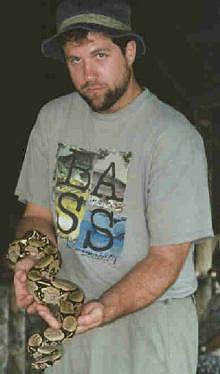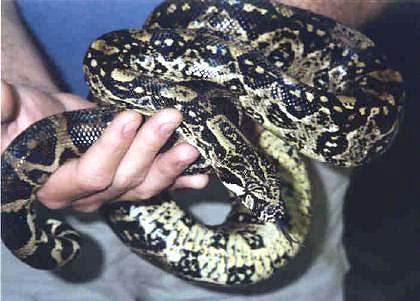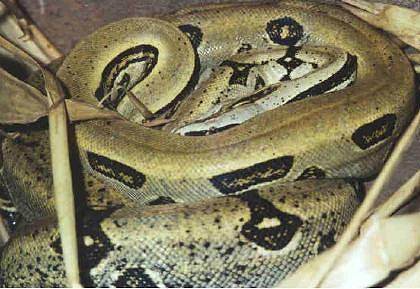- ! ! ! ! ! ! ! ! ! ! ! ! ! Latest Updates
- ! ! ! ! ! ! ! ! ! ! ! ! ! Latest Updates
- ! ! ! ! ! ! ! ! ! ! ! ! ! Latest Updates
- Home
- Boa constrictor subspecies
- Boa constrictor - Interesting Facts
- More boa information
- Boa Gallery
- Boas for Sale
- Contact
 The author with a Boa c. constrictor caught in Ecuador, 50 miles northern to the Peruvian border
The author with a Boa c. constrictor caught in Ecuador, 50 miles northern to the Peruvian border
It’s obvious that the subspecific recognition of most boas is in poor state due the lack of information in the past.
Especially when it comes to Boas from Ecuador & Peru.
Copes description of Boa ortonii ( 1878 ) was a very vague description in that it really didn’t go into much detail as to what the snakes looked like and it was also vague in its locality specifications. ( Piura South to la Libertad on the west coast of Peru )
On a recent trip to Ecuador I found some interesting information about Ecuadorian Boa c. imperator,
Boa c. longicauda of Tumbes Peru, a new Ecuadorian Boa & Peruvian Red Tail Boas ( Ortonii ? )
Our description of Boa c.longicauda done back in 1991 was a lengthy challenge to compile all the information necessary to prove the subspecific recognition of this Peruvian Boa. We also could not go to Tumbes Peru due to a border dispute between Ecuador & Peru that goes on till this day. Our biggest challenge was to find out the difference between this new boa ( longicauda ) and the older description of ortonii. Assuming acceptance of the validity of ortonii, only the province of Tumbes lies outside its range on the northwest coastline of Peru. Tumbes is literally a peninsular of land that extends north into Ecuador. So it is surrounded by Ecuador with the exception of the southwestern part. So the question we ask is “ why couldn’t Boa c. longicauda’s range extend into Ecuador ? “
While talking to Dennis Sargent at the 2000 Daytona National Reptile Breeders Expo, it was brought to my attention that longicauda’s range may extend into Ecuador. He showed me a book called Serpientes de Ecuador by Santos & Moreno. It had a picture of what we refer to as longicauda, it referred to its range as being the states of Guayas & Manabi.
So therefore I embarked on a Journey to the country in question, Ecuador. I learned a valuable lesson while on a trip to the Cape York Peninsular, Australia. I had spent 2 weeks looking for pythons in the jungle and found nothing. It wasn’t till I found a guide that was interested in snakes that I did find them.
Ecuador is no different. I immediately started talking to people and letting them know of my interest in Boas. I was fortunate enough to find a guide that was very interested in snakes and told me he knew where we could see some Boas.
My trip started on the East side of Andes Mountains in search of Red Tailed Boas Boa c. constrictor, near a town called Wayusentsa. It was a 2.5 hour South East trip by plane ( 12 seater ) from Quito, Ecuador. Then we took a 1.5 hour river trip by canoe. Our final stop was the Kapawi lodge. An Eco lodge in the rainforest that caters to naturalist, birdwatchers and people that just want to see the true untouched wilderness.
The following morning my wife and I met up with our guide and an Achuar Indian guide. The Achuar guide was the only native I met that was not afraid of snakes. Most natives in this area would kill snakes when they saw them. They also would not go in the river because of fear of Anacondas. My guide had seen a large Bushmaster the day before I arrived, but it was killed by the natives. He was frustrated that he couldn’t get through to the people and let them know that killing these snakes was not good for the eco system.
We then proceeded via canoe South down the Pastaza River. We were around 50 miles north of the Peru border . This trip was no different from any of my other Jungles trips. We spent many days in search of Boas and found only one. In such a vast place these snakes can be anywhere, 30 meters up in a tree or burrowed deep in a hollow root. Our guide introduced us to A very unique Achuar that had a few pets. One was a beautiful Boa.
 Pet Boa c. constrictor of the Achuar indian
Pet Boa c. constrictor of the Achuar indian
The location was a peninsular of land created by the intersection of the Capahuari River and the Pastaza River. The boa was collected on this property. This boa was very similar to what people are calling Iquitos Peruvian Red Tailed Boa or Boa c. ortonii.
It has 19 dark dorsal saddles and that yellow/brown background color. Obviously it could not have been ortonii since Copes description describes ortonii as a snake from the West side of the Andes.
This snake was obviously a constrictor constrictor ( East of the Andes ). But was Copes original specimen moved from one part of the country to the other ? Or was Copes ortonii the boa that some breeders are calling Black Peruvian Red Tails ?
We know he was not referring to Boa c. longicauda because of Scale counts that do not match up from his original description of ortonii. I also tend to think that snakes from the north west coast of Peru would tend to be very dark boas. We also know that constrictor comes from the East of the Andes and imperator from the west.
Boa c. longicauda - Boa c. ortonii difference | Loja Boa | Peru Tumbes
So The second leg of my tour was back to the West side of the Andes. A place called Guayaquil. I had met a Peruvian that told me he could take me to Tumbes Peru with no problems, a 5 hour drive from Quayaquil. But when I talked to the local Ecuadorians, they told me it was not safe and cautioned me not to go. The Ecuadorians seemed sincere, so I took their advice. The Peruvian on the other hand seemed a little suspicious.
Therefore it was back to Quito. My guide in the Amazon had told me about a person in Quito that had a Serpentarium. I wasted no time in finding it. Luckily it was only 2 blocks from my Hotel ( Fate ). I met a wonderful person, Maria Elena Barragan of the Fundacion Herpetologica. I asked her if she had any Boa c. longicauda? She said “ Yes I have one, but it is not from Tumbes. Its from Loja , Ecuador “ ( Loja is a town that is South west of the Andes and is very hot, dry dessert like area. I will refer to this boa as the “ Loja boa “ in this article ).
 Boa c. longicauda (?) from Loja/Ecuador
Boa c. longicauda (?) from Loja/Ecuador
I told her I would love to see it. Finally, an Ecuadorian longicauda ? I couldn’t believe my eyes. It was a dark, black snake. Similar to longicauda but yet very different too. The Loja boa has about 31 dorsal saddles snout to vent ( longicauda have 19-21 and ortonii have 15-19 ) it has unique dorsal blotches in that they are diamond shaped and It lacked the wide head spear and blue head of longicauda. The head reminded me of an Argentine boa head. The specimen I examined was female.
I was hoping it to be male so I could compare the probe depths to longicauda ( Longicauda males probe very deep, hence the name “ longtail “ ). This specimen was small for a ten year captive.
About 1.5 meters long. Maybe it’s a dwarf ?
 The "Loja - Boa" a dwarfish morph?
The "Loja - Boa" a dwarfish morph?
Again, I always tended to believe that the “ Dark Boas “ are usually from cooler climates. This Loja boa was no different. The climate from which it comes from gets quite cool in the winter ( or rainy season ) about 15 degrees celsius and quite hot & dry in the summer.
Maria Elena also had some very interesting Ecuadorian Boa c. imperator. At first glance they looked like very light yellow longicauda. They have black tails and black outlined dorsal saddles. Some dorsal saddles did not connect. I also had trouble counting the saddles because all of the boas were partially striped. So the blotches were irregular. These snakes also lacked the wide head spear of longicauda.
 Boa c. imperator (?) out of the Provincia Esmeraldas, Rio Verde, North west Ecuador
Boa c. imperator (?) out of the Provincia Esmeraldas, Rio Verde, North west Ecuador
But they were beautifull Black & Yellow specimens. They were small boas, about 1.5 meters and they were sexually mature and had reproduced 2 times. They all derived from a gravid wild caught female from the vecinity of Provincia Esmeraldas, Rio Verde, North west Ecuador.
This gravid snake was captured in 1989 and donated to the foundation. Looking at these Ecuadorian imperator raised a question in my mind. Can these snakes be the result of a naturally occurring intergrade between the northern most locality of longicauda & Southern most locality of imperator ? More research is necessary.
 A natural intergrade between Boa c. imperator and Boa c. longicauda?
A natural intergrade between Boa c. imperator and Boa c. longicauda?
Therefore I not only found longicauda in Ecuador, but may have found some new boas ( the Loja longicauda Boa and Ecuadorian imperator ). Our research has only just started. I still want to get some shed skins from these two boas ( the Loja & imperators ) to examine the differences between them and the Tumbes longicauda. I am also planning a trip to Loja, Ecuador in search of this rare boa. Maria Elena expressed to me that it may be quite challenging to find one since her specimen is the only one found in over ten years. In addition I am also currently trying to find out if a preserved holotype specimen of Copes ortonii is in the collection at Harvards Museum of Comparative Zoology. I am curious to see what it really is. I will write another article on the subject as soon as more information is available to me.
In conclusion I would also like to emphasize how important it is to help preserve these boas in their natural setting. Considering how rare it is to see one in the wild, just imagine how many thousands are exported each year to Europe & the U.S. We must all practice Captive breeding to insure the survival of each wild race of boa and help keep their bloodlines pure.
Vincent P. Russo
